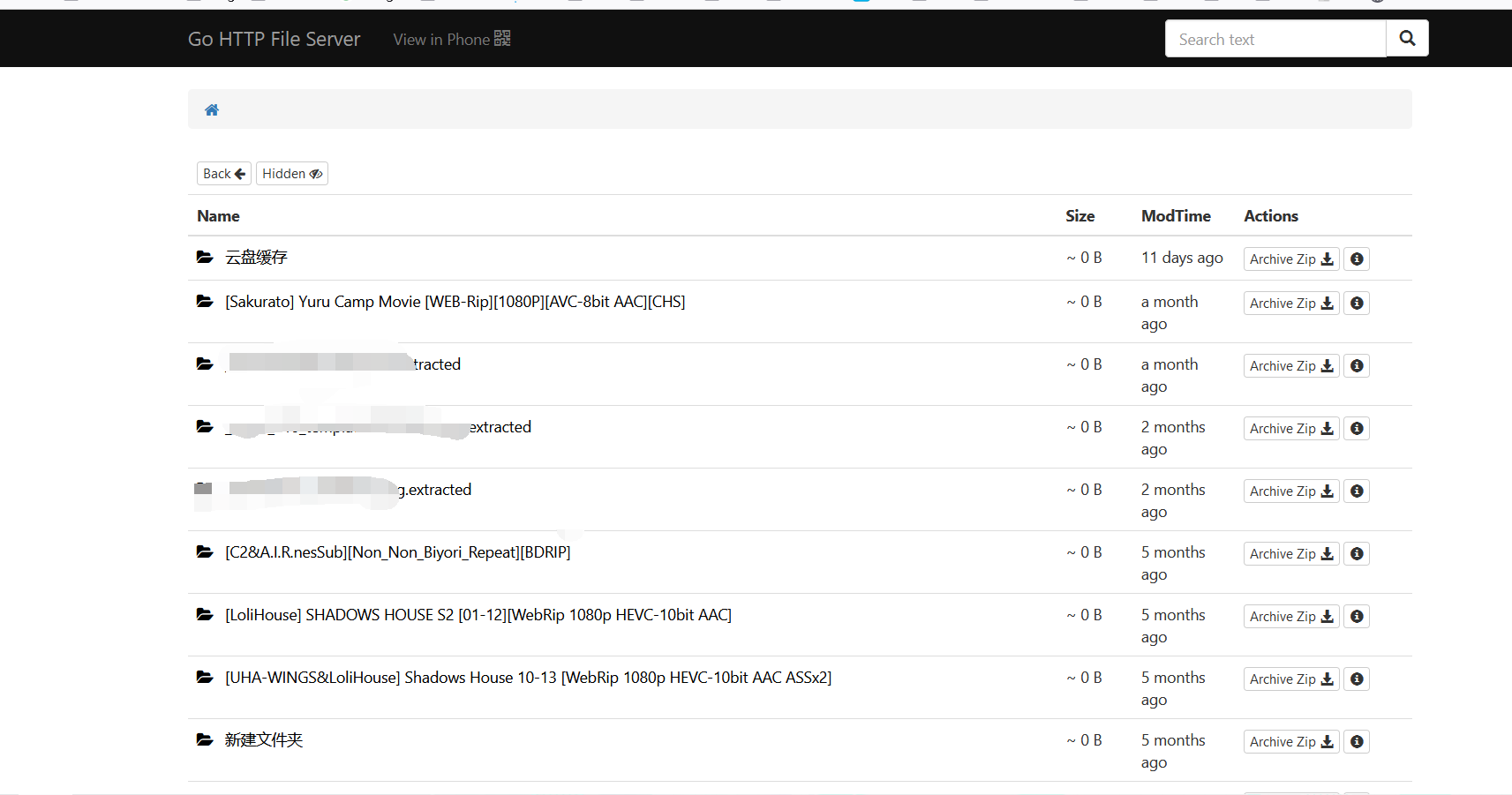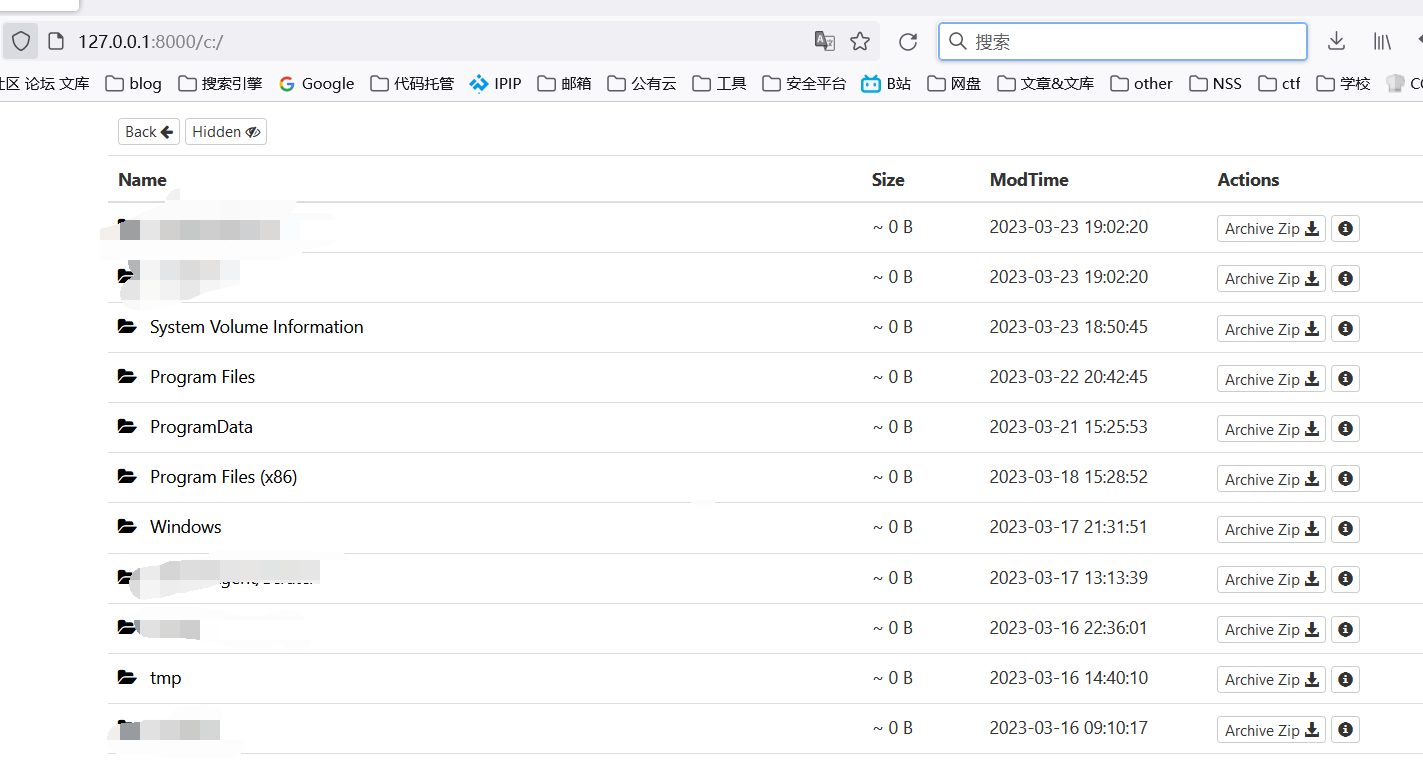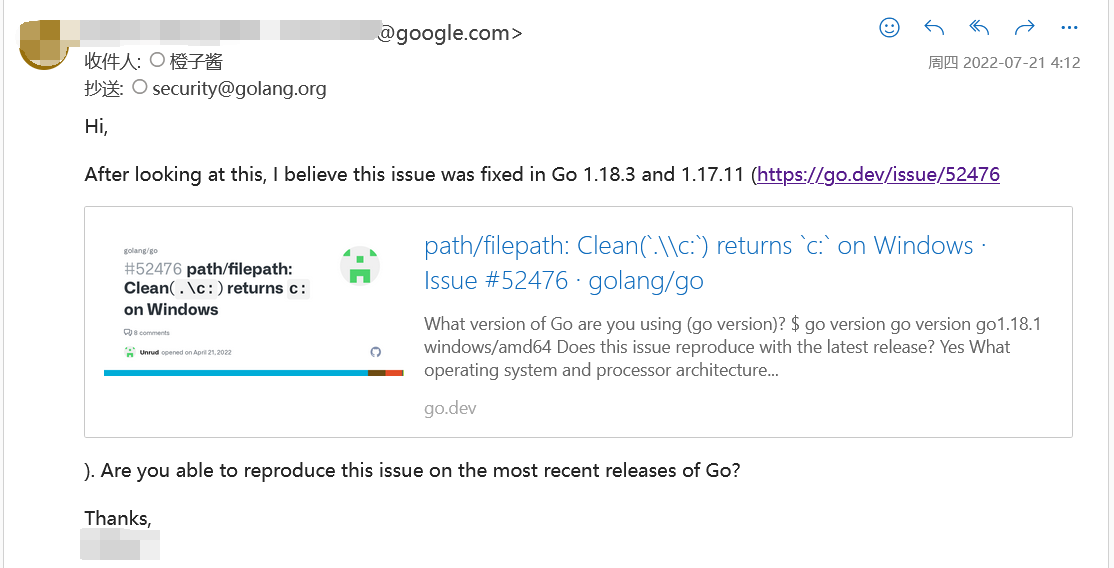前言
一天,我看完了番剧后,闲着无聊审计了一下我用来做内网共享的小工具——"Go HTTP File Server"。
这是一个文件服务器,可以快速搭建http服务器共享文件.
启动的默认路径为当前路径(./)

代码审计
非常安全的代码?
这个工具默认是没有鉴权的 所以我们直接看文件浏览的部分
func (s *HTTPStaticServer) getRealPath(r *http.Request) string {
path := mux.Vars(r)["path"]
if !strings.HasPrefix(path, "/") {
path = "/" + path
}
path = filepath.Clean(path) // prevent .. for safe issues
relativePath, err := filepath.Rel(s.Prefix, path)
if err != nil {
relativePath = path
}
realPath := filepath.Join(s.Root, relativePath)
return filepath.ToSlash(realPath)
}
func (s *HTTPStaticServer) hIndex(w http.ResponseWriter, r *http.Request) {
path := mux.Vars(r)["path"]
realPath := s.getRealPath(r)
if r.FormValue("json") == "true" {
s.hJSONList(w, r)
return
}
if r.FormValue("op") == "info" {
s.hInfo(w, r)
return
}
if r.FormValue("op") == "archive" {
s.hZip(w, r)
return
}
log.Println("GET", path, realPath)
if r.FormValue("raw") == "false" || isDir(realPath) {
if r.Method == "HEAD" {
return
}
renderHTML(w, "assets/index.html", s)
} else {
if filepath.Base(path) == YAMLCONF {
auth := s.readAccessConf(realPath)
if !auth.Delete {
http.Error(w, "Security warning, not allowed to read", http.StatusForbidden)
return
}
}
if r.FormValue("download") == "true" {
w.Header().Set("Content-Disposition", "attachment; filename="+strconv.Quote(filepath.Base(path)))
}
http.ServeFile(w, r, realPath)
}
}
乍一看上去,这段代码好像没有什么问题。它使用了 Go 标准库中的 filepath.Clean (去除 ..) 和 filepath.Join(合并路径) 函数,来防止目录穿越。
标准库中的漏洞
我刚好还有些空余时间,所以我又开始检查 Go 标准库中的函数实现。
filepath.Clean
func Clean(path string) string {
originalPath := path
volLen := volumeNameLen(path)
path = path[volLen:]
if path == "" {
if volLen > 1 && originalPath[1] != ':' {
// should be UNC
return FromSlash(originalPath)
}
return originalPath + "."
}
rooted := os.IsPathSeparator(path[0])
// Invariants:
// reading from path; r is index of next byte to process.
// writing to buf; w is index of next byte to write.
// dotdot is index in buf where .. must stop, either because
// it is the leading slash or it is a leading ../../.. prefix.
n := len(path)
out := lazybuf{path: path, volAndPath: originalPath, volLen: volLen}
r, dotdot := 0, 0
if rooted {
out.append(Separator)
r, dotdot = 1, 1
}
for r < n {
switch {
case os.IsPathSeparator(path[r]):
// empty path element
r++
case path[r] == '.' && r+1 == n:
// . element
r++
case path[r] == '.' && os.IsPathSeparator(path[r+1]):
// ./ element
r++
for r < len(path) && os.IsPathSeparator(path[r]) {
r++
}
if out.w == 0 && volumeNameLen(path[r:]) > 0 {
// When joining prefix "." and an absolute path on Windows,
// the prefix should not be removed.
out.append('.')
}
case path[r] == '.' && path[r+1] == '.' && (r+2 == n || os.IsPathSeparator(path[r+2])):
// .. element: remove to last separator
r += 2
switch {
case out.w > dotdot:
// can backtrack
out.w--
for out.w > dotdot && !os.IsPathSeparator(out.index(out.w)) {
out.w--
}
case !rooted:
// cannot backtrack, but not rooted, so append .. element.
if out.w > 0 {
out.append(Separator)
}
out.append('.')
out.append('.')
dotdot = out.w
}
default:
// real path element.
// add slash if needed
if rooted && out.w != 1 || !rooted && out.w != 0 {
out.append(Separator)
}
// copy element
for ; r < n && !os.IsPathSeparator(path[r]); r++ {
out.append(path[r])
}
}
}
// Turn empty string into "."
if out.w == 0 {
out.append('.')
}
return FromSlash(out.string())
}
调试了一遍后,我发现 filepath.Clean 对路径处理非常完美。这个函数可以将路径中的冗余部分去除,同时可以处理不同操作系统下的路径分隔符问题.
filepath.Join
但是 filepath.Join 函数就不太一样了,这个函数在 Plan9、Unix 和 Windows 三个操作系统类型下有着不同的实现。
func join(elem []string) string {
// If there's a bug here, fix the logic in ./path_plan9.go too.
for i, e := range elem {
if e != "" {
return Clean(strings.Join(elem[i:], string(Separator)))
}
}
return ""
}
在 Unix 系统下,filepath.Join 非常简单,它会在Clean之后直接拼接路径,没有任何问题。
func volumeNameLen(path string) int {
if len(path) < 2 {
return 0
}
// with drive letter
c := path[0]
if path[1] == ':' && ('a' <= c && c <= 'z' || 'A' <= c && c <= 'Z') {
return 2
}
// is it UNC? https://msdn.microsoft.com/en-us/library/windows/desktop/aa365247(v=vs.85).aspx
if l := len(path); l >= 5 && isSlash(path[0]) && isSlash(path[1]) &&
!isSlash(path[2]) && path[2] != '.' {
// first, leading `\\` and next shouldn't be `\`. its server name.
for n := 3; n < l-1; n++ {
// second, next '\' shouldn't be repeated.
if isSlash(path[n]) {
n++
// third, following something characters. its share name.
if !isSlash(path[n]) {
if path[n] == '.' {
break
}
for ; n < l; n++ {
if isSlash(path[n]) {
break
}
}
return n
}
break
}
}
}
return 0
}
func join(elem []string) string {
for i, e := range elem {
if e != "" {
return joinNonEmpty(elem[i:])
}
}
return ""
}
// joinNonEmpty is like join, but it assumes that the first element is non-empty.
func joinNonEmpty(elem []string) string {
if len(elem[0]) == 2 && elem[0][1] == ':' {
// First element is drive letter without terminating slash.
// Keep path relative to current directory on that drive.
// Skip empty elements.
i := 1
for ; i < len(elem); i++ {
if elem[i] != "" {
break
}
}
return Clean(elem[0] + strings.Join(elem[i:], string(Separator)))
}
// The following logic prevents Join from inadvertently creating a
// UNC path on Windows. Unless the first element is a UNC path, Join
// shouldn't create a UNC path. See golang.org/issue/9167.
p := Clean(strings.Join(elem, string(Separator)))
if !isUNC(p) {
return p
}
// p == UNC only allowed when the first element is a UNC path.
head := Clean(elem[0])
if isUNC(head) {
return p
}
// head + tail == UNC, but joining two non-UNC paths should not result
// in a UNC path. Undo creation of UNC path.
tail := Clean(strings.Join(elem[1:], string(Separator)))
if head[len(head)-1] == Separator {
return head + tail
}
return head + string(Separator) + tail
}
// isUNC reports whether path is a UNC path.
func isUNC(path string) bool {
return volumeNameLen(path) > 2
}
func sameWord(a, b string) bool {
return strings.EqualFold(a, b)
}
在 Windows 系统下,filepath.Join 函数的实现要复杂得多,因为需要处理路径分隔符和 UNC 路径等特殊情况。
到这里就变得有趣了一些 filepath.Join 的输入不完全是用户控制的 Clean函数会把用户输入和固定路径一起处理
这个工具刚好出现了一个非常特殊的情况
文件服务器本来想要限制访问当前目录下的文件
filepath.Join("./",'已经处理后的用户输入')
如果输入的路径是./ abc/1.txt
Clean处理后会变成 abc/1.txt Clean去除了开头的设定的./
这个处理在linux系统下没有问题
但是在windows 系统下 如果我们构造路径组./ c:/1.txt
Clean处理后会变成 c:/1.txt
显然从Clean处理后把当前目录下的路径变为了c盘根目录
在这里,filepath.Clean 函数的处理并没有避免目录穿越问题,反而造成了一个安全漏洞。
最终在http server 上复现成功


小插曲
提交给go 官方之后才发现这洞3个月前就被修复了. 我电脑上的go版本一直没更新 23333

漏洞issue
https://github.com/golang/go/issues/52476
漏洞影响&利用条件
- 使用
filepath.Clean/filepath.Join处理路径 - 左侧被拼接路径为
./ - 右侧路径可完全控制
- Go编译Windows二进制文件使用 Go 1.18 <1.18.3 Go 1.17 <1.17.11 (不在维护的版本应该不会修复)
- 目标二进制部署在windows 操作系统
标准库的漏洞会影响编译分发出的二进制文件
解决方法
更新go到最新版本 重新编译发布二进制文件
 跳跳糖
跳跳糖
